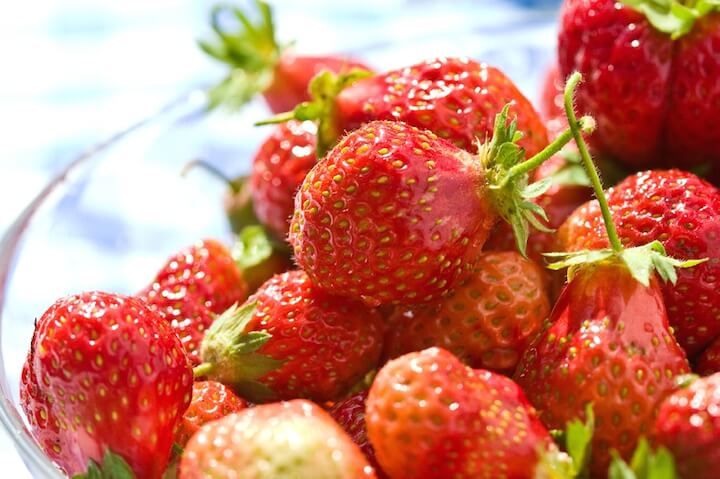Strawberries are one of the most beloved fruits worldwide, enjoyed in everything from desserts to smoothies and even savory dishes. In this guide, we’ll dive into all things strawberries—their history, health benefits, varieties, and how to incorporate them into your daily life.
Whether you’re a long-time fan of this juicy red fruit or just starting to explore its many uses, this comprehensive post will provide all the information you need to appreciate strawberries even more. Let’s uncover the fascinating world of strawberries!
1. The History and Origins of Strawberries
Strawberries, with their sweet and tangy flavor, have been enjoyed for thousands of years. Their history dates back to ancient civilizations, where they were prized for both their taste and medicinal properties. The earliest known strawberries were small, wild varieties found in Europe and North America.
Over the centuries, strawberries have evolved, and with the advent of agriculture, they became a staple in many cultures. Today’s commercial strawberry is a result of careful cultivation and hybridization, with the most common varieties being Fragaria × ananassa. These hybrid strawberries have contributed to the mass production of the fruit that we see in grocery stores around the world.
While strawberries are now a global fruit, they were initially found in the wild. Early cultivators knew their value for both culinary uses and medicinal benefits, using them to treat everything from sore throats to digestive issues.
2. The Nutritional Powerhouse: Health Benefits of Strawberries
Strawberries are not just delicious; they’re packed with essential nutrients that offer numerous health benefits. These vibrant red fruits are a great source of vitamin C, antioxidants, fiber, and manganese. Just a handful of strawberries can provide your body with vital nutrients that support overall health.
One of the key benefits of strawberries is their high vitamin C content. Vitamin C is essential for immune function, skin health, and wound healing. Strawberries also contain anthocyanins, antioxidants that help fight oxidative stress in the body, reducing inflammation and lowering the risk of chronic diseases such as heart disease.
In addition to their antioxidant properties, strawberries are rich in fiber. Fiber aids in digestion, promotes gut health, and helps regulate blood sugar levels. Incorporating strawberries into your diet can support cardiovascular health, enhance digestion, and contribute to a healthy weight management plan.
3. Different Varieties of Strawberries and How to Choose the Best Ones
Not all strawberries are created equal, and knowing the differences between varieties can help you choose the best ones for your needs. While the most common variety is the June-bearing strawberry, other types, such as ever-bearing and day-neutral strawberries, also have their own unique characteristics.
June-bearing strawberries are typically harvested once per year, usually in the late spring or early summer. They are known for their large, flavorful berries and are perfect for making jams, jellies, or fresh consumption. Everbearing strawberries, on the other hand, produce fruit throughout the growing season, making them a great option for those looking for a steady supply of berries.
Day-neutral strawberries are a newer variety, producing fruit continuously from early summer to fall. They are smaller but still sweet and perfect for snacking or baking. When shopping for strawberries, look for those that are firm, bright red, and free from blemishes. You’ll want to choose strawberries that are fragrant, as their aroma indicates freshness.
4. How to Grow Strawberries at Home: A Step-by-Step Guide
Growing strawberries in your backyard can be a rewarding experience. Whether you have a spacious garden or a small balcony, strawberries can be grown in containers, raised beds, or directly in the ground. Start by selecting a location that gets plenty of sunlight—strawberries thrive in full sun.
To plant strawberries, begin by preparing the soil. It should be well-drained, rich in organic matter, and slightly acidic. If planting in containers, make sure they have drainage holes, as strawberries don’t like standing water. Once your soil is ready, space your strawberry plants about 12 to 18 inches apart to give them room to spread.
Watering is essential, especially during dry spells. However, overwatering can lead to root rot, so ensure your strawberry plants receive the right balance of moisture. Mulching around the base of the plants can help conserve water and prevent weeds. Fertilize your strawberries regularly with a balanced fertilizer to encourage healthy growth.
5. Incorporating Strawberries Into Your Diet: Delicious Ideas and Recipes
Strawberries are incredibly versatile in the kitchen. From smoothies and salads to baked goods and jams, there are endless ways to enjoy this delicious fruit. Start your day with a strawberry smoothie by blending fresh or frozen strawberries with yogurt, milk, or plant-based alternatives. Add some chia seeds or spinach for extra nutrients.
For a healthy snack, dip strawberries in dark chocolate or top them with a dollop of whipped cream. They can also be a fantastic addition to savory dishes, like a strawberry and spinach salad with balsamic vinaigrette. The sweet and tangy flavor of strawberries pairs beautifully with cheese, nuts, and even meats like chicken or pork.
Don’t forget to try your hand at homemade strawberry jam or preserve them in a pie. If you’re looking for something lighter, a refreshing strawberry sorbet or frozen yogurt can be the perfect treat during warm months. The possibilities are endless when it comes to incorporating strawberries into your meals.
6. Strawberry Picking: Where to Go and What to Expect
One of the best ways to enjoy strawberries is by picking them yourself. Strawberry picking is a popular activity for families and individuals alike, offering a fun day out and the chance to enjoy fresh, organic fruit straight from the farm.
Before you go, check local farms or pick-your-own strawberry patches to find out when they open for the season. Most farms offer picking from late spring through summer, depending on the climate in your area. Bring your own containers, and be prepared to spend a few hours in the fields.
While picking strawberries, be mindful of how you harvest them. Gently pull the fruit from the plant, leaving the green caps attached to preserve freshness. Once you’ve picked your bounty, enjoy them right away or take them home to freeze or preserve for later use.
7. Preserving Strawberries: Freezing and Canning Tips
Strawberries are typically available in abundance during the summer months, but there are ways to enjoy them year-round. Freezing and canning are two popular methods for preserving strawberries, ensuring that you can enjoy the taste of fresh strawberries even when they’re out of season.
To freeze strawberries, wash them thoroughly and remove the stems. You can freeze them whole or slice them, depending on your preference. Spread the berries out on a baking sheet to prevent them from sticking together, then transfer them to airtight containers or freezer bags. Frozen strawberries are perfect for smoothies, baking, or enjoying as a snack.
Canning strawberries is another way to preserve their flavor. Make strawberry jam or preserves by cooking strawberries with sugar and pectin. Once sealed in jars, these preserves can be stored for months, allowing you to enjoy the taste of summer long after the season has ended.
Strawberries are a fruit that brings both joy and numerous health benefits. From their rich history to their versatility in the kitchen, there’s no shortage of reasons to incorporate strawberries into your daily life. Whether you’re growing them at home, picking them fresh from the farm, or enjoying them in a delicious dish, strawberries will continue to be a beloved fruit for generations to come.
So go ahead, savor the sweet taste of strawberries, and reap the many benefits they have to offer. Happy strawberry picking, eating, and enjoying.

